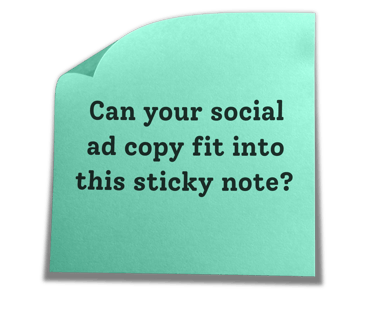
7-Minute Read
The length of your content can make or break its success. Sometimes you need to get right to the point (think a social media post or promotional email). Other times it pays to go long (hello search-optimized blog posts).
Finding that sweet spot isn’t always straightforward. And there are exceptions to every rule. (Case in point—the long, but iconic copy on Dr. Bronner’s soap labels.)So how long should your social post, email, newsletter or blog be?
It depends...but don’t let that frustrate you! While content length is important, it’s not usually something you need to obsess over while you’re writing—at least not in the beginning.
The perfect time to assess content length is after you’ve written your first draft and before you start editing. That’s because the length of your content will ultimately depend on:
1 – The details/features/benefits you need to convey.
2 – Your audience (their goals, personal preferences and prior knowledge).
3 – The context you’re presenting it in.
If you can accomplish what you need to without seeming longwinded, length won’t be a huge concern. But if you don’t feel like your first draft has checked all the boxes, paying closer attention to length can steer you in the right direction.
Here are some general rules you can follow to determine whether you’re holding back or if you’ve said too much:
Content Length Guidelines & BEST PRACTICES
SOCIAL MEDIA COPY (ADS & ORGANIC POSTS)
BEST PRACTICES & RECOMMENDATIONS
Some social media platforms have strict length guidelines for organic (unpaid) posts, like Twitter’s famous 280-character limit. But other platforms like Facebook will let you ramble whether it’s a good idea or not.
The Sticky Note Test
If you’re writing copy for a social media ad (one you pay for), the good news is you’ll have a set amount of characters to work with. But remember—no one is forcing you to max out your character limit. If you can fit all of your social ad copy into a sticky note, you're onto something great. Resist the urge to add more!

It’s better to create multiple, shorter ads that each touch on a specific benefit than to try to cram every detail into one ad. (Remember, humans have a limited attention span.) Not only will this approach allow you to be more direct, you’ll get a better idea of the messages that resonate with your audience when you dig into performance analytics.
Don't forget that on social media you’re vying head-to-head with competitors for your customers’ eyes. If you need to add a few words to infuse your brand’s personality into the mix—do it!
| SOCIAL MEDIA CHARACTER LIMITS |
|
| Facebook Image Ad | Primary Text: 125 characters Headline: 40 characters Description: 30 characters |
| Organic FB Post | 60,000+ characters…but try to keep it under 80 |
| Twitter Image Ad | Tweet Copy: 280 characters Website Title: 70 characters |
| Twitter Post | 280 characters |
| Instagram Image Ads & Organic Posts | 2,200 characters…but try to keep it around 125 |
| LinkedIn Sponsored Content Ad | Ad Headline: 150 characters Descriptive Copy: 100 characters |
| LinkedIn Company Page Post | 700 characters |
TLDR: Keep it short and sweet, using as few words as possible to convey your message—but just enough to give your writing personality.
PROMOTIONAL EMAILS
BEST PRACTICES & RECOMMENDATIONS
Customers on your mailing list already know a thing or two about your company, so skip the introduction to your brand. Keep your copy limited to the topic at hand (sales, new arrivals, special offers, etc.). And trust that if the reader needs to know more about you, they’ll click on your logo, which should bring them to your website.
Body copy isn’t the only place to be concise. Subject lines are as important as the content itself! Keep these to the point, between 5-7 words and between 30-40 characters or less.
PRO TIP: Use a subject line scorer to help you craft winning subject lines.They’re not perfect (what technology is?) but they’re still a helpful tool. And just by using one a few times, you’ll get practice on writing concise, interesting subject lines. Try this Subject Line Tester from CoSchedule.
| IDEAL EMAIL CHARACTER COUNTS |
|
| Subject Lines | 20-40 characters (around 3-7 words) |
| Preview Lines | 70 characters (roughly two medium-length sentences) |
| Body Copy | 50-125 words |
TLDR: Customers don’t need your company backstory every time you send an email. Make reading it worth their time by keeping copy limited to what they get out of it: discounts, coupons, tips—that kind of stuff.
EMAIL NEWSLETTERS
BEST PRACTICES & RECOMMENDATIONS
Unlike promotional emails, e-newsletters can go into more depth about what you’re up to. Just don’t let “go into depth” trick you into thinking you have to put everything out there at once.
Use links to your advantage! Want to tell customers about a new product? Skip the list of benefits and link to the product page instead. Want to show off a new hire? Link to their company profile. Got a new blog to share? You get the picture…
Consider your layout as well. You don’t want to throw everything into a single paragraph under a single header. The best newsletters are segmented to help the reader move from one section to the next. And they include plenty of visuals to keep things entertaining.
Here’s an example of one of our newsletters, which generally covers news related to our industry, our latest blogs and recent hires (plus a quick joke, just because).
| IDEAL EMAIL NEWSLETTER CHARACTER COUNTS |
|
| Subject Lines | 20-40 characters (around 3-7 words) |
| Preview Lines | 70 characters (roughly two medium-length sentences) |
| Body Copy | As long as it needs to be—but 200 words is a good benchmark |
TLDR: Use links to expand information presented in your email. And remember to use subheads, dividers and pictures to break everything up.
BLOGS
BEST PRACTICES & RECOMMENDATIONS
The “perfect” blog length is tricky to estimate since there are tons of formats to choose from.
A simple how-to blog (think something like “How to Whistle”) should be straightforward and aligned with your reader’s goal. You don’t need to give readers the history of whistling—it won’t help them whistle better and that’s not what they’ve come for.
Now take a blog like this one. Maybe you want content length recommendations because charts are pretty to look at. But more likely, you’re reading this because you want to improve your content quality by writing more concisely. If I only provided a list without any context, that wouldn’t translate to understanding. And it wouldn’t help you meet your goal.
Of course, some people will only be interested in that list. That’s why it’s crucial to offer shortcuts and cues that steer readers to the info they’re searching for.
Did you notice at the top of this blog there’s an option to download our list of content length recommendations? Or that important messages are written in bold? These are the kinds of shortcuts that make blogs more scan-able.
Images and infographics are also helpful shortcuts—don’t be afraid to let them tell the story for you! And be sure to use descriptive headers and subheads, allowing readers to scan and skim your content for the info they’ve come for.
Does your reader need to strap in for a long one? Let them know! Add an estimated read time to the top of your blog to minimize frustration and encourage reading to the end.
A note on blog length and SEO: typically, the blogs that perform the best from an SEO perspective tend to be on the lengthier side. Part of that is because a longer blog can work in more keywords and phrases naturally, while shorter keyword-heavy blogs often get dinged for keyword stuffing.
If you want to get into the weeds on blog length from an SEO-perspective, check out Hubspot’s guide to blog post lengths in 2021. Their methodology is rock-solid and based on their treasure trove of data. (If you’re the type who goes nuts for in-depth analysis—you’ll have a field day with this one!)
| IDEAL BLOG POSTS LENGTHS (BASED ON HUBSPOT DATA) |
|
| General Posts | 2,100 – 2,400 words |
| Listicle | 2,300 – 2,600 words |
| How-to Blog | 1,700 – 2,100 words |
| "What Is" Blog | 1,300 – 1,700 words |
TLDR: The length of your blog will depend heavily on your reader’s goal and the format you choose.
Now that you’re armed with some best practices, download our Content Length Cheat Sheet and bust it out whenever you need a handy reminder.
Keep refining your content creation skills! Read these blogs for more pro tips:
- Learn why blogs underperform—and what you can do about it.
- Learn which digital channel is right for your marketing efforts.
- Learn to write alt tags that improve SEO and content performance.






Submit a Comment